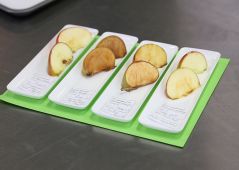Enzymic Browning Experiment

A number of mechanisms are responsible for browning reactions in foods. This experiment will examine the action of an enzyme called polyphenol oxidase which is naturally present in many fruits and vegetables.
Materials
- 8 x 250ml beakers (labelled potato 1, 2, 3 and 4, and apple 1, 2, 3, and 4)
- 200g potatoes
- 200g apples
- vegetable oil
Method
Wash & chip 200g of potato.
Place 40g of potato chips into each of the four “potato” beakers.
In beaker 1, cover chips with fresh tap water.
In beaker 2, cover chips with cooled, freshly boiled water.
In beaker 3, cover chips with cooled freshly boiled water and then cover the surface of the water with oil.
Leave potato chips in beaker 4 with no additions.
Examine after 1 and 2 hours and after 1 and 2 days. Note the colour of each sample.
Set up the experiment again, but use apple instead of potato.
Comment on your results.
Effect of chemical and physical factors on browning
This experiment investigates the influence of heat and particular chemical substances on the process.
Materials
- Eight 250ml beakers
- An electric kettle
- A thermometer to monitor temperature up to 100°C
- 100g apples divided into five equal sized portions.
- 100g potato divided into five equal sized portions.
- WARNING do not consume any of these solutions or inhale their vapour:
- 5% acetic acid solution
- 0.5% ascorbic acid solution
- 0.05% sodium metabisulphite solution
1. Boil the kettle and half fill the first beaker – immediately add one portion of chopped apple. Leave for 3 minutes and drain. Turn out the apple.
2. Using freshly boiled water and cold water adjust the temperature of the three further beakers to 80, 60 and 40°C (try to work with similar – half full beaker quantities)
3. Into each beaker add a separate portion of chopped apples.
4. Leave each portion for 3 minutes and then drain the water and turn out the apple samples to leave all the apples samples for one hour.
5. While you are waiting – look at the effect of specific chemicals on browning
6. Place one portion of chopped potato into each of four 250ml beakers.
7. Cover the potato pieces as follows:
a. distilled water
b. 5% acetic acid solution
c. 0.5% ascorbic acid solution
d. 0.05% sodium metabisulphide
8. Compare the colour of each sample with freshly cut apple and potato after 1 and 2 hours (and after a further 1 and 2 days).
9. Comment on your results.


